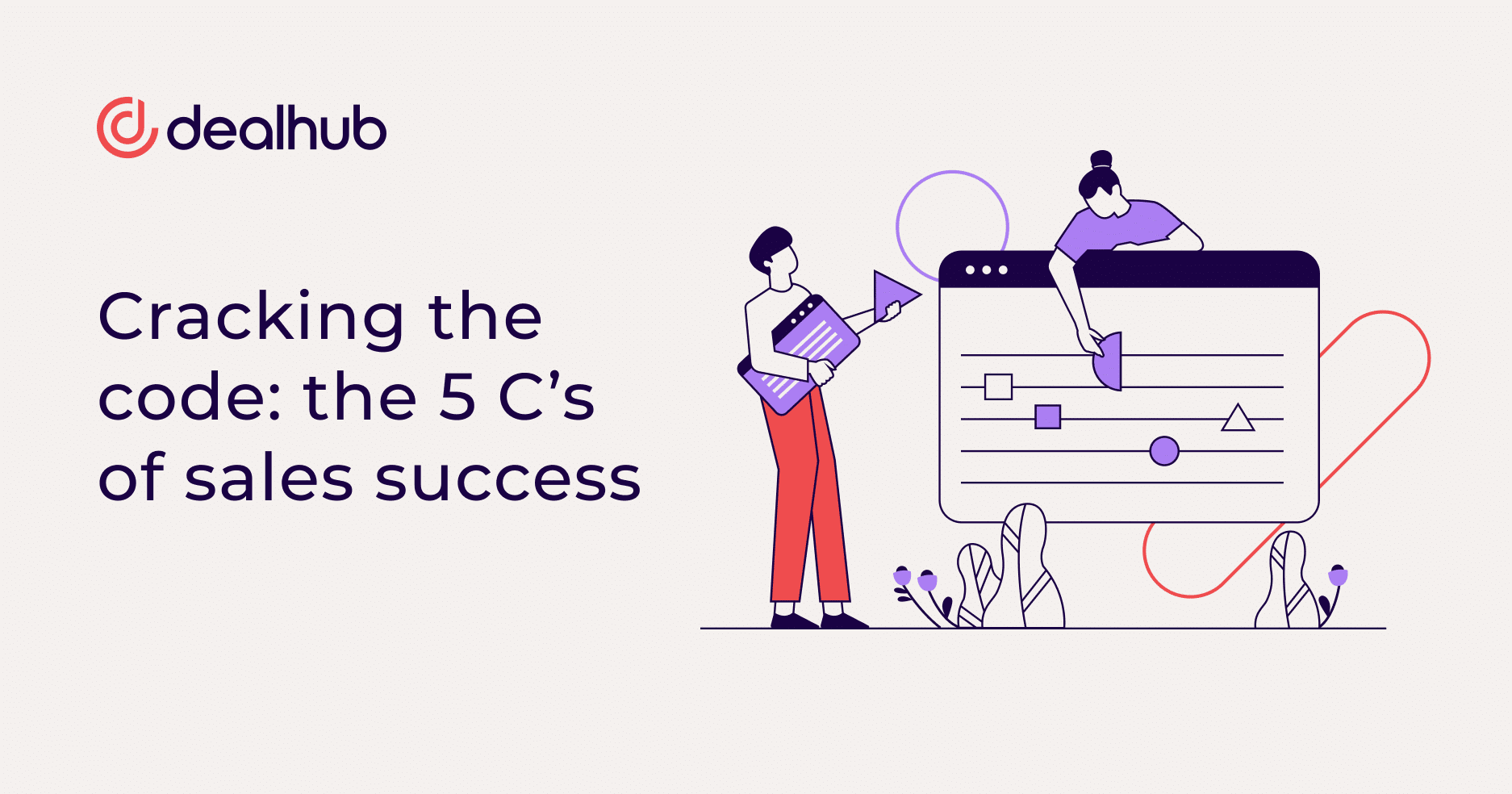The 5 C’s of sales success
Each of the 5 C’s is essential for long-term revenue generation. However, you may need help imagining ways to implement them into your sales process. Below, we outline each element and provide a real-world example from an industry-leading company to show you how big names use these very tactics into practice. By seeing how others leverage these approaches, you will be inspired to integrate each into your own sales strategy.
- Customer-centricity: putting the customer first
Customer-centricity is the cornerstone of successful sales. Companies that place customers at the center of the sales process are purposefully prioritizing long-term relationships over one-off transactions. With a customer-focused strategy, a sales professional aims to understand the buyer’s journey so that they can provide ongoing support and value. They also strive to customize each client interaction based on preferences, challenges, and circumstances.
The end goal, of course, is to engender customer loyalty. Customer-centricity involves consistently delivering value to cultivate long-term clients that will continue to buy, are open to cross-selling and up-selling opportunities, and ideally become brand evangelists, helping you build brand awareness and trust within your industry.
Zappos is a prime example of a company that excels in customer-centric sales. The company goes above and beyond to ensure customer satisfaction, offering free shipping and returns, 24/7 customer support, and a 365-day return policy. Their customer service representatives are empowered to do whatever it takes to make customers happy, whether providing product recommendations, resolving issues, or simply engaging in friendly conversation. Zappos understands that a positive experience leads to loyal customers who recommend the brand to others.
They actively cater to individual customer segments by putting their customer’s experiences at the center of every business decision they make. Their “Customer Service for Anything” program, for example, enables customers to reach out via whichever channel they prefer, and having a mix of channels connected to Zappos’ tech stack also allows the company to appeal to and serve different customer audiences.
- Communication: the art of customer empathy
Effective communication is about more than just delivering a polished sales pitch. It’s about listening actively and asking the right questions to uncover what truly matters to the customer. Tailoring your communication style to different personas and situations demonstrates empathy and builds rapport to effectively win over customers and close the sale.
Apple retail stores are renowned for their unique design and customer-centric approach, prioritizing empathy and communication to create meaningful visitor experiences. They start by creating open, inviting spaces with a minimalist and modern aesthetic. Their product displays also encourage exploration and interaction by offering visitors a tactile, hands-on experience. This is reinforced via hands-on learning experiences and workshops where customers can explore Apple products and software with the guidance of knowledgeable staff. These interactive sessions foster engagement, collaboration, and learning in a supportive environment.
Apple stores prioritize personalized customer service, tailoring interactions to each individual’s needs and preferences. Employees are referred to as “Geniuses” and “Creative Pros,” and they undergo extensive training to develop both technical expertise and interpersonal skills. They are trained to listen actively, empathize with customers’ needs and concerns, and communicate solutions in a clear and approachable manner.
- Closing: sealing the deal

Closing effectively is essential to the sales process. Being well-versed in various closing techniques allows sales representatives to be ready for multiple scenarios to make the purchasing experience seamless.
Sales representatives often employ a variety of techniques to effectively close deals, with three common approaches being prevalent in their arsenal. The Assumptive Close operates on the premise that the customer has already made the decision to purchase, seamlessly guiding them towards completing the transaction as a natural progression. On the other hand, the Summary Close involves summarizing the essential points of the sales conversation, reinforcing the value proposition, and then explicitly asking for the sale. Lastly, Alternative Close offers customers multiple options, all of which result in a successful sale, prompting them to choose the one that aligns best with their preferences or needs. Each technique is strategically employed to drive successful outcomes in the sales process, catering to the diverse needs and preferences of customers.
Amazon is a prime example of a company that effectively closes customers through various strategic approaches. For example, Amazon has mastered making the checkout process as smooth and convenient as possible. With features like one-click ordering and saved payment methods, Amazon assumes the sale and moves to reduce friction for customers, making it easy for them to complete their purchases quickly.
Pre-checkout, Amazon is the master of leveraging advanced algorithms to provide personalized product recommendations based on customers’ browsing and purchase history. Like a digital version of the “alternative close,” the company suggests relevant products that align with customers’ interests and preferences, which increases the likelihood of closing a sale. It also incorporates customer reviews and ratings prominently on product pages, reinforcing each product’s value proposition and making customers feel confident about their choices.
4. Consistency: building trust and reliability
Consistency breeds trust and reliability in sales. Delivering on promises and maintaining a consistent brand image across all touchpoints instills customer confidence. Whether it’s the tone of voice in marketing materials or the level of service provided post-purchase, consistency builds credibility. Despite challenges or changes, staying true to your values and commitments reassures customers.
Starbucks offers a master-class in consistency by providing customers with the same in-store experience worldwide. Whether ordering a latte in New York City or Tokyo, you can expect the same taste and quality every time. This consistency is achieved through rigorous standards for sourcing, roasting, and preparing coffee and ongoing training for baristas to ensure consistency in drink preparation.
Starbucks has cultivated a distinct brand identity and atmosphere that is maintained across its stores. From the iconic green logo to the cozy interior design, the company strongly emphasizes providing consistent customer service and experience. Customers have come to expect friendly greetings at the counter and an efficient order-taking process, and they appreciate the personalized beverage recommendations.
5. Continuous learning: the path to growth
In sales, you can never grow complacent. Continuous learning and self-improvement are crucial to staying ahead in a competitive industry. You’ll need to continuously leverage feedback and analyze data to maintain your competitive edge. By monitoring performance and your direct competition, you can identify improvement areas, intuit market changes, and quickly refine strategies. Fostering a culture of learning within sales teams encourages innovation and adaptability.
Salesforce reinforces continuous learning with its Trailhead platform, which provides extensive training and resources for constant skill development. The platform serves as a comprehensive learning and training resource for Salesforce users and professionals. Users can access Trailhead anytime, anywhere, using a computer or mobile device, making it convenient for ongoing learning and skill development.
The platform provides:
- Hands-on experience through interactive exercises so users can apply what they’ve learned in a simulated Salesforce environment.
- Role-based learning paths are tailored to job functions, such as sales representatives, marketing professionals, administrators, developers, and more.
- The ability to collaborate via forums, groups, and events where users can connect, share knowledge, and ask questions.
- Badges and credentials that reward and recognize user achievements and skills.
As Salesforce and its offerings expand, Trailhead offers users training and support to ensure they can easily navigate the platform. That way, anyone can become a true Salesforce expert and specialize according to their interest or role.
Becoming a sales savant
Professionals can achieve remarkable success by mastering the five essential C’s of sales (customer-centricity, communication, closing, consistency, and continuous learning). We’ve illustrated how five organizations, Zappos, Amazon, Apple, Starbucks, and Salesforce, implement these strategies to empower their sales teams and impress their customer base. Let these five real-world examples be the inspiration you need to supercharge your own sales process.
Whether you’re a seasoned sales veteran or just starting out, embracing these principles will set you on the path to becoming a sales leader. Remember: put the customer first, listen attentively, close confidently, maintain consistency, and, above all, embrace the power of consistently learning. That way, you’ll always be at the top of your game.




